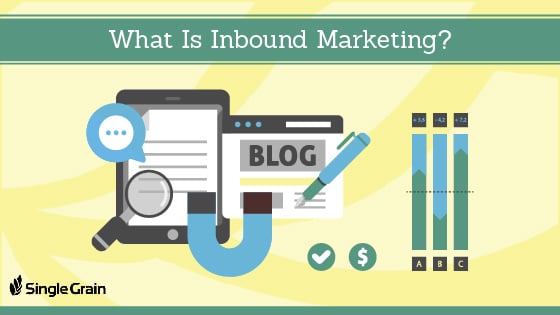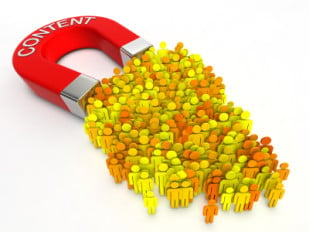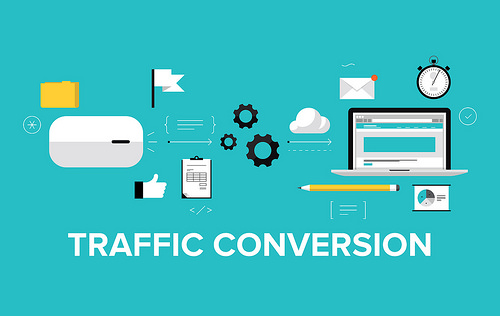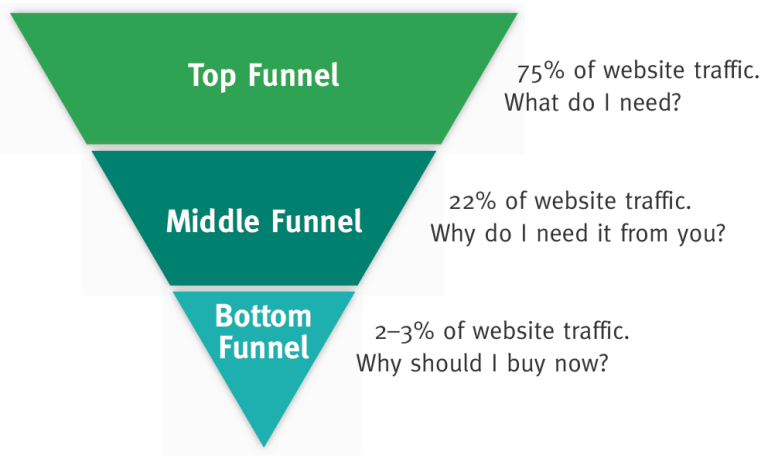
You’ve likely heard the term, you may even believe you have a good grasp of the basics. But chances are you’re thinking of inbound and content marketing as the same thing. People often confuse the two, much like Bill Paxton and Bill Pullman.
Inbound is the most popular kid at school these days, captain of the football team and holding the place of honor at the cool table. But for many of us, it’s an enigma. A mystery wrapped in a puzzle.
So what is inbound marketing? Let’s start with what it’s not.
Inbound Marketing = Content Marketing?
Afraid not. Many industry “experts” make this mistake, so don’t feel bad if you fall in that camp. It’s not the same thing. The terms are not interchangeable, despite the fact that many sites do just that.
Inbound marketing is any marketing activity that brings leads and customers to you rather than you heading out into the world to find them. Inbound is frequently done via content marketing, though it’s not the only way. It may include SEO, social media, videos, e-mail campaigns, podcasts, infographics, blogs and webinars.
So, content marketing—the creation and distribution or useful content to connect and engage with a specific target audience—is just one inbound marketing tactic…but it’s perhaps the most important one.

Put another way, all content marketing is essentially inbound marketing, but all inbound is not content.
“Inbound Marketing is about getting found online, through search engines and on sites like Facebook and YouTube and Twitter…” ~David Meerman Scott
And you want to be found online. Consider these facts:
- Google handles over 100 billion searches each month.
- B2B consumers make an average of 12 online searches before checking a specific business website.
- 93% of buying cycles begin with an online search.
- 90% of web surfers browse or research products online, and a full 50% of those intend to buy.
It all begins with getting found. Just like the Hollywood starlet getting discovered while serving coffee at Starbucks.
Inbound tactics like content and SEO make you visible to a world that is increasingly looking for answers, information, products, and services online. It gets you on their radar without the pushy sales methods that everyone hates so much. This is a very good thing for your bottom line, but it’s not a get-rich-quick scheme. It takes time.
“Content marketing is a long-term relationship. It’s not a one night stand.” ~Ross Simmonds
More Useful Stuff: How to Build a High-Performance Content Marketing Strategy
The Content Conundrum
Creating and distributing all that content—blog posts, e-books, slideshows, videos, infographics, podcasts, articles, case studies, white papers, graphics, webinars—can eat a lot of your workday.
But just look at the payoff:
- 68% of people spend time reading about brands online (good)
- 80% appreciate learning about businesses via their content (better)
- 70% feel closer and 78% perceive a relationship after reading custom content (best)
And with billions of people online at any one time (primarily consuming content, hanging out on social media, and conducting searches), that’s a lot of attention and positive feelings coming your way.
So inbound marketing—and by extension, content—takes a lot of blood, sweat, and tears, but the ROI is unparalleled.
How to Harness Content in Your Inbound Efforts
Content marketing needs concrete goals, a specific and identified audience, a distribution plan, and analytics to help measure and define success. Tall order? Sure. But well worth it.
“Marketing is telling the world you’re a rock star. Content marketing is showing the world that you are one.” ~Robert Rose
Your efforts need to be guided by your marketing goals, and those might include brand awareness, lead nurturing, conversion/sales, customer service, retention/loyalty, up-selling, or creating passionate subscribers (happy customers make fantastic cheerleaders in cyberspace and beyond).
Create and make available something that someone wants, and they’ll come to you. Right to your digital doorstep. All you have to do is open it and say “hi.” Connection made. Conversation started.
More Useful Stuff:
- 6 Steps to Prove to Your CEO that Inbound Marketing Can Generate ROI
- 10 Content Marketing Myths that Are Killing Your Conversions
The Inbound vs. Outbound Debate Is Over
With apologies to Don Draper, outbound (or traditional) marketing is going the way of the dodo. It doesn’t speak to the audience, it speaks at the audience, shoving messages under their nose whether they like it or not.
Television and radio ads, billboards, online banners and popups, prints ads, phone calls, flyers, direct (i.e. junk) mail, and so on are all examples of outbound marketing agency. It’s aggressive in its pitch: Buy our product now! You need this laundry detergent because it will make your life beautiful, fragrant, and 39% better!
These are also known as interruption marketing tactics, because they do just that: they interrupt the audience’s television show or song or their perusal of the latest issue of Cosmo. And people hate being interrupted.
44% of direct mail is never opened, 86% of us skip through commercials (thank you PVRs!), and 84% of 25-34 year olds have bounced from a website because of in-your-face ads.
“We need to stop interrupting what people are interested in and be what people are interested in.” ~Craig Davis
And this is where inbound and content marketing come in and sink the game-winning 3-pointer at the buzzer. Inbound marketing pulls the audience in and engages in a two-way conversation. It provides value by giving them something they want, need, love, or are interested in…with no strings attached or expectations.
They come to you. There’s no hard sell. In fact, there’s no sell at all. Inbound is about creating relationships, building awareness, providing a solution to some problem or pain point, and building trust.
Then, when it’s time to buy, you’re first in their mind. So:
- Outbound = push
- Inbound = pull
- Outbound = outdated
- Inbound = in style
“If you have more money than brains, you should focus on outbound marketing. If you have more brains than money, you should focus on inbound marketing.” ~Guy Kawasaki
So What’s the Big Deal?
Let’s look at some stats:
- Inbound leads have a 14.6% close rate compared to only 1.7% for outbound
- Businesses save $14 for every new customer acquired when they prioritize inbound
- Inbound leads cost up to 61% less than outbound
- 80% of B2B decision makers prefer getting information from articles rather than ads
- Inbound tactics cost up to 62% less but generate 3x the leads compared to outbound (read that one again…I know, right!)
- 77% of online shoppers prefer (and, dare I say it, appreciate) permission-based promotions via e-mail. Get them to your site with your inbound efforts, get their details, and reel them in.
- Average cost-per-lead drops by as much as 80% after a consistent 5 months of inbound marketing
And you’ll be in good company. According to Hubspot’s annual State of Inbound report, 3 out of 4 marketers are now prioritizing their inbound efforts, and a whopping 84% of small businesses are primarily using the strategy.
Inbound marketing achieves a higher ROI than outbound methods regardless of a company’s size or marketing budget. Share on X
Want to increase your odds even more? Check your metrics at least three times per week, and let them guide your efforts. You’ll be 20% more likely to see a positive return on your investment.
The best marketers monitor:
- sales lead quality
- sales
- conversion rate
- website traffic
- brand lift
- SEO rank
- customer renewal rates
- subscriber growth
- and more
It’s not just about traffic.

(Source: Compfight)
The CMI and MarketingProfs B2B Content Marketing Report paints an equally impressive picture:
- 88% of respondents are using content marketing
- An average 28% of marketing budgets are earmarked for content, while the most effective companies allocate up to 42%
- 76% will increase their content production over the previous year
- B2B marketers use an average of 13 different tactics, including social media (93%), blogs (81%), videos (79%), infographics (67%), and online presentations (65%). It’s all about variety.
- The four most popular social platforms are LinkedIn (94%), Twitter (87%), Facebook (84%), and YouTube (74%). Marketers employ an average of 6 different platforms. Again…variety and diversity rule the day.
But wait (you might be saying), that’s all great for B2B businesses. But I’m in the B2C arena. Fear not! CMI has you covered, too:
- 76% of respondents are using content marketing, and 77% plan to produce more content than last year
- Popular tactics include social media (90%), illustrations & photos (87%), videos (82%), blogs (77%), and infographics (62%). B2C marketers utilize an average of 12 different tactics and channels.
- The top social platforms are Facebook (94%), Twitter (82%), YouTube (77%), and LinkedIn (76%).
- B2C marketers spent an average of 32% of their budget on content marketing in 2015
That’s the big deal. The very, very big deal.
Get Onboard with Inbound
But how do you put it all together? Unfortunately, there is no one-size-fits-all solution. No cookie-cutter template that’ll work for everyone. Inbound marketing may be a fickle toddler, but there are plenty of best practices and insider tips to get you started.
How We Use the Web
Think about your own Internet usage. What do you do online? If you’re like most people (and let’s assume you are), you spend a lot of time conducting search queries. We have the collected knowledge of human civilization at our fingertips and in our pockets. Literally. And that’s pretty amazing.
We can instantly find the answer to virtually any question. Those answers can spin us off in new directions, leading to different questions, and introducing us to new websites, brands, and personalities. It’s a smorgasbord. An all-you-can eat buffet. And it is glorious.
Billions of searches each month means billions of opportunities to connect. 2.3 billion social media users means more opportunity to engage than you can shake a virtual stick at. Americans check their social accounts a remarkable 17 times each day! In short, there’s a huge, captive, and engaged audience out there waiting to meet you.

(Source: Pixabay)
Using inbound tactics—with a healthy dose of content—brings a steady flow of laser-targeted traffic to you. You know they’re interested in whatever you have to offer before you even shake their hand (digitally speaking) because they followed your link, or downloaded your content, or commented on your wall. You have what they want.
Don’t blow it by trying to close the deal on the first date. Get to know them.
Inbound Recipe for the Modern Marketer
So, what do you need to succeed? Inbound is a diverse creature. It’s not just content. The best inbound marketers use a mix of:
- Valuable and useful content distributed on a variety of channels
- Search engine optimization (SEO) of well researched keywords and phrases (and don’t ignore long tail!)
- Blogging (still one of the best things you can do for your brand…blogs increase indexed pages by 434%, indexed links by 97%, generate 67% more leads, and 97% more inbound links)
- Social media activity and sharing (41% of companies on Facebook report more leads, and businesses on Twitter generate 2x as many leads)
- Personal appearances at events and live online forums
- Permission-based email campaigns
The goal with inbound is to get known and spread brand awareness. You want to have your name on the tip of everyone’s tongue and grow your fame and authority.. Be visible. Be approachable. Be helpful. But don’t try to sell too soon. Modern consumers are sick and tired of aggressive sales tactics and most will simply walk away if you do it.
That’s the beauty of inbound…you’re selling without selling. The relationship that you cultivate—either real or perceived—makes the sales part almost automatic. People buy for emotional reasons. They buy from brands and companies they know, trust, and love. And inbound marketing grows all of that for you.
Inbound and the Buyer’s Journey
Let’s stop and consider for a moment the way we shop and buy. Even when you physically head out into the real world, that journey often starts online.
A Nielsen survey commissioned by Google found that over three-quarters of consumers conduct searches on their smartphone while on the go, and over half of them want to make a purchase within the hour.
So start with search. Understand that proximity matters to them…they want their search results to be nearby (use location indicators and keywords). And make purchase immediacy a priority (make it easy for them to buy online, to contact you via e-mail or phone, or find your physical location).
This all falls into the sales funnel, whether it starts online and migrates to the real world, or takes place entirely in cyberspace.
More Useful Stuff: How to Optimize Your Content Strategy with the Buyer’s Journey
The Inbound Sales Funnel
Your inbound marketing needs to walk them through your funnel, from top to bottom. What you provide and offer at each section will be the difference between a successful sale and waving bye-bye as they claw their way back to the top and out.

(Source: Greenhouse Agency)
The inbound sales funnel is typically divided into three sections, and each one requires its own ingredients:
- Top of the Funnel (ToFu). This is the largest part of your funnel, welcoming prospects from all over. This is often labeled the Awareness or Learning Phase. They may not know you or your brand, or how you may help fulfill a need they have, but they’re on a fact-finding mission. They’ve entered a few words or a question into a search engine, and for some as-yet-unknown reason, your site was listed in the results…so they click.
- Your inbound efforts at this stage are best spent on SEO, useful blog posts that satisfy a need or problem, pay-per-click (PPC) campaigns that target a specific keyword, infographics, videos, and social media engagement with optimized hashtags and a targeted audience. They’re looking for answers and solutions.
- Middle of the Funnel (MoFu). This is the Consideration Phase of their journey. You have their attention. Could you be the solution to their problem? Do you have what they’re looking for?
- Prospects in the middle need to be convinced. Offer a case study, tutorial, tool, or e-book (with specifics about you and your product/service). Display some stellar testimonials. Craft an epic landing page that addresses their issue or concern. Show them how committed you are to this relationship.
- In short, demonstrate why you’re better than their other suitors (you didn’t think they were just dating you, did you?). Most importantly, you need to “hide” whatever content is up for grabs at this point behind a conversion form. You need their details (names and e-mail addresses) to ease them along the funnel. Give them a very clear call-to-action at this stage…what should they do next (provide you with their details), and how do they do it (a simple form or phone call).
- Bottom of the Funnel (BoFu). This is where you want all your prospects to end up: at the bottom. This is the Decision Phase: to buy, or not to buy. If you’ve pulled in the right target, and convinced them of your prowess, they’ll be prepared to show you the money.
- At this stage you need to nurture your leads and sweeten the deal. Suggest a consultation. Send them a coupon. Connect them to a sales associate. Provide a free trial. Activate an automated e-mail campaign (with the hard-won address you procured in the middle) further explaining why they need you and the benefits they’ll receive, and alleviate any remaining concerns on their part. Leads at this stage are this close (I’m holding my fingers really close together) to pulling the trigger and buying. Gently nudge them that way.
It’s paramount that you create some way to collect details (e-mail and names) in the middle. That turns a nameless prospect into a warm lead. And that’s a very good thing.
If you remember one thing, remember this:
Overall, you’re trying to increase the volume at the top of your funnel with your SEO efforts, targeted and valuable content (blog posts, infographics, videos), active social media participation, and well-researched PPC campaigns, while increasing conversion at the bottom of your funnel by making your offer too good to refuse, and serving up personalized (get their details!) and actionable next-steps. Close the deal…but only at the bottom.
More Useful Stuff:
- How to Create the Ultimate Marketing Funnel (Templates Included)
- What’s the Right Content for Each Stage of the Marketing Funnel?
The Buyer Decision Process
The traditional buyer decision process looks like this:
- Problem or need identified
- Information and research
- Evaluation of available options
- Purchase decision
- Post-purchase evaluation
This can easily be applied to our inbound funnel:
- ToFu – Problem/need identified, and research stage
- MoFu – Evaluation of options
- BoFu – Purchase decision, and post-purchase evaluation
See? It goes together like Bert and Ernie.
Just remember that your work is NOT done once you get that sale. Follow up afterwards to create loyal, satisfied customers. Bad word-of-mouth can kill you because anybody can reach millions of people in a matter of minutes, so go that extra mile.
More Useful Stuff:
Final Thoughts
So, do you have a plan? Like a good reporter, you need to ask the right questions when sketching your inbound marketing.
- Who? Identify your ideal customer.
- Where? Identify where they “live” online so you can make yourself available there.
- What? What do they want or need, and how does your product/service provide it for them? And more selfishly, what are your specific goals for this particular campaign (increase traffic, generate leads, increase conversions, spread awareness…)?
- Why? Why are you the best choice? You have to be crystal clear on your unique selling proposition (USP) before you even think about marketing to anyone.
- How? How are you going to help them find you? What tactics are you going to employ…remembering that the best marketers use 12-13 different ones. Various types. Various channels.
- When? Right now.
Inbound marketing is not going away anytime soon, and for that we should all be thankful. It relies on brains, not budget. It literally allows the small guys—the mom ‘n’ pop businesses—to compete on a global scale.
Through SEO, social media engagement, PPC, content distribution (especially blog posts, videos, and visuals), and live appearances, you can pull prospects to you.
What’s inbound marketing? The marketing you’ve been waiting for: affordable, uber-effective, and possible for everyone.
Hopefully you learned all about inbound marketing! But if you just want an expert marketing agency to do it for you, click here.



